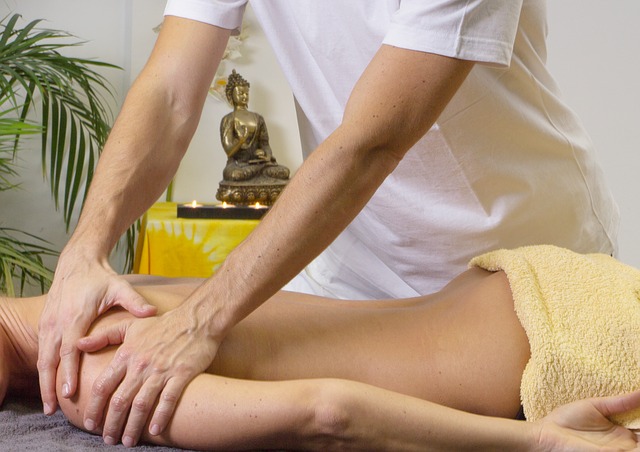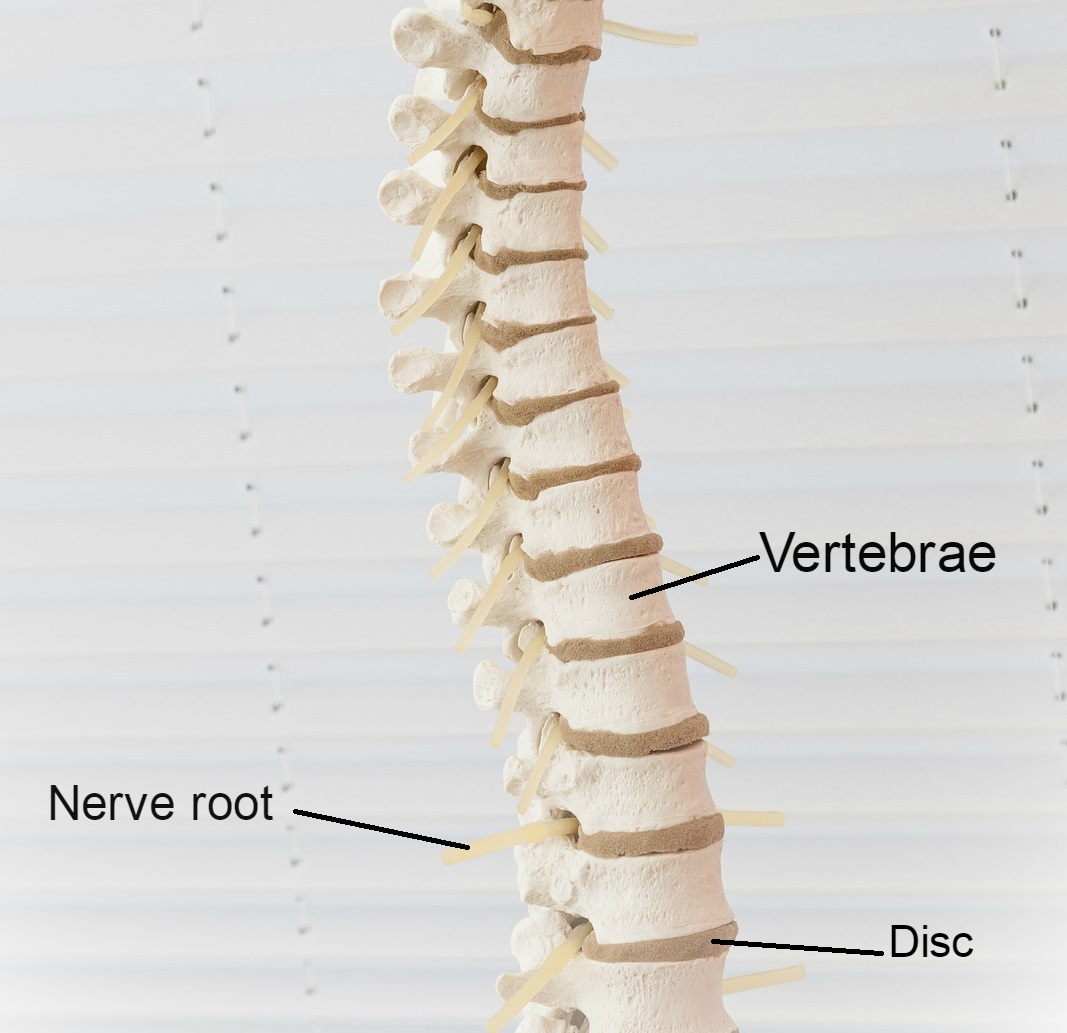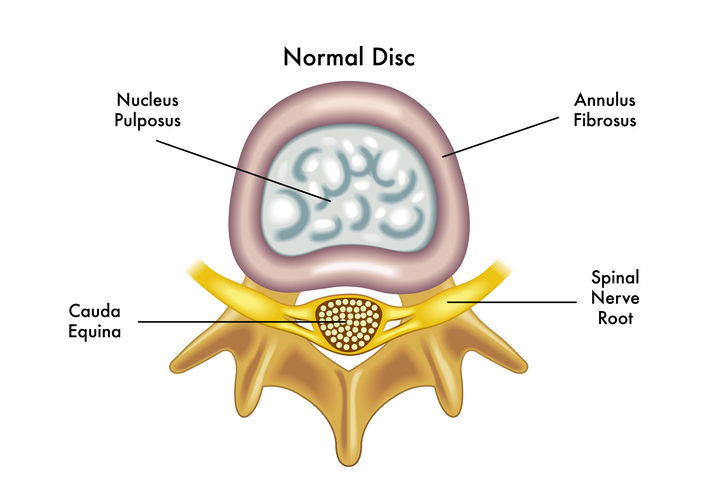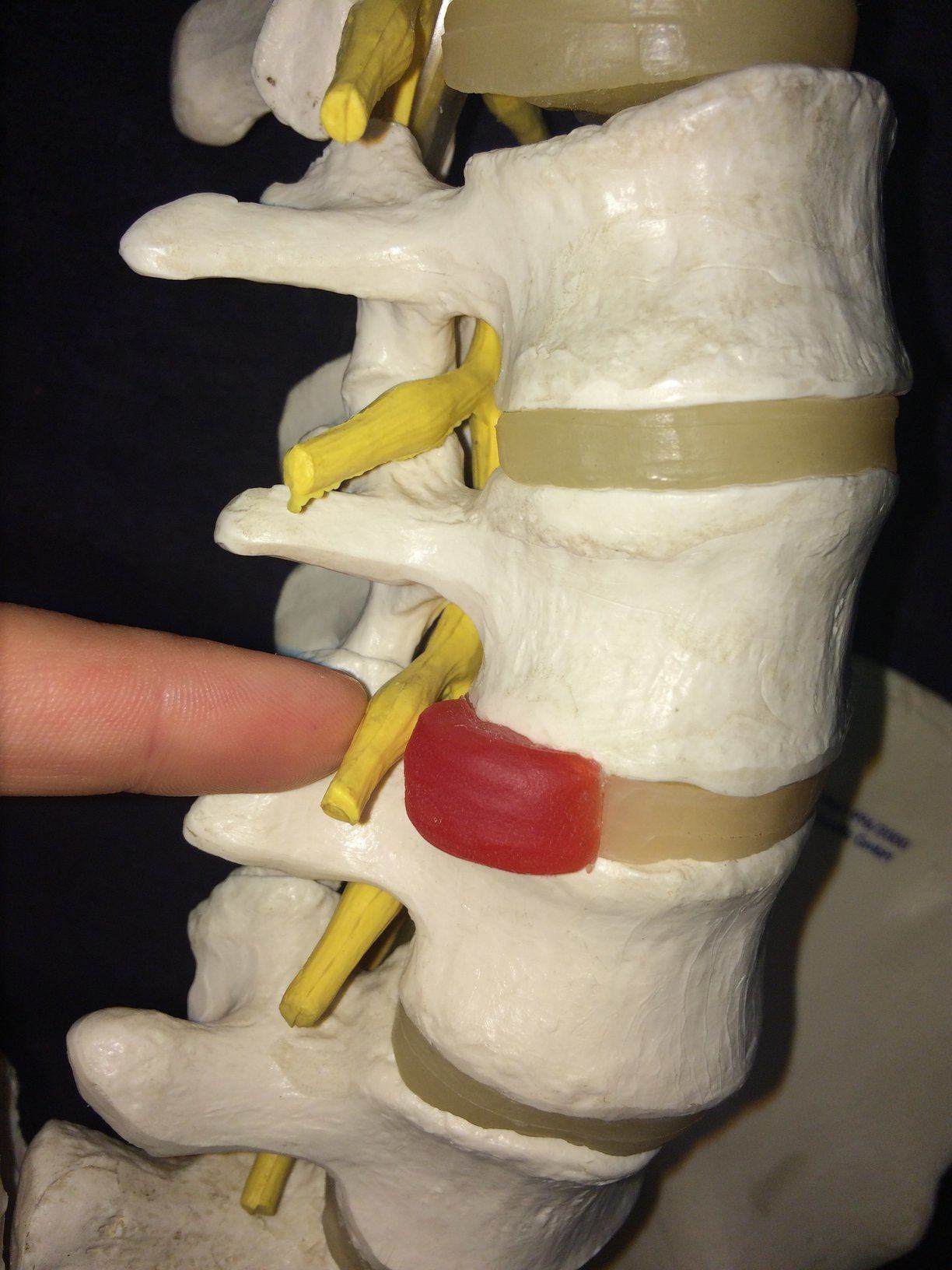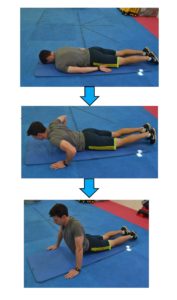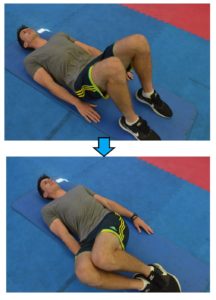Today, we are going to discuss the difference between two commonly used terms when talking about sciatica. Let’s dive into the difference between a bulging disc vs a herniated disc.
Bulging Disc vs Herniated Disc – What’s the Difference?
To understand the difference between a bulging disc and a herniated disc, we first need to understand what a spinal disc problem actually is.
Before we start, watch the video below which will cover many of the questions you might have:
Before we dive in, please be aware that we are part of the Amazon Affiliate programme. This page may contain Amazon affiliate links, so if you choose to purchase a product for your sciatica that we recommend through a link on this page, we will receive a small commission at no extra cost to you. This helps us keep Overcome Sciatica alive! Thank you for your support. Please be assured that we only ever recommend products that we truly believe can help.
What is a Spinal Disc?
To understand this better, let’s talk a bit about the anatomy of the spine.
The human spine is made up of 24 vertebra (your “back bone”) which are funny shaped bones stacked on top of each other. These vertebrae start in the lowest part of your back and run all the way to the top of your neck.
The top 7 vertebra in the spine are called the “cervical” vertebrae. These make up your neck. We call them C1, C2, C3 etc… All the way down to C7 at the base of the neck.
Your mid-back is made up of the 12 thoracic vertebra. These are called T1 to T12.
Your lower back is made up of 5 large lumbar vertebra. These are called L1 to L5. L5 is the lowest vertebra in the spine.
Below that is your sacrum. Your sacrum is the funny shaped bone that joins the right and left parts of your pelvis together. Although the sacrum is one individual bone, there are 4 sets of nerves that exit the sacrum. We call these levels S1-S4.
Between each vertebrae is a spinal disc – a tough sac made up of strong cartilage, filled with fluid. We name these discs based on the vertebrae above and below the disc. For example, if we are talking about the disc between L1 and L2, we would call it disc L1/L2.
Although the discs are much stronger than a donut, it might help to imagine the design of the discs like a jam donut – made up of tough outer layers filled with fluid.
The discs are very important. They help the spine move normally. Without them, we couldn’t walk, stand or move our spines.
What is a Bulging or Herniated Disc?
Over time, the discs in the spine can suffer normal wear and tear that occurs from repetitive movements throughout our lives. This process happens to everyone.
However, if one part of the disc has weakened more than others, it can lead to something called a bulging or herniated disc.
This describes the event where the strong outer fibres of the disc split (or “herniate”) and the fluid within the disc leaks out at the region where the injury occurred.
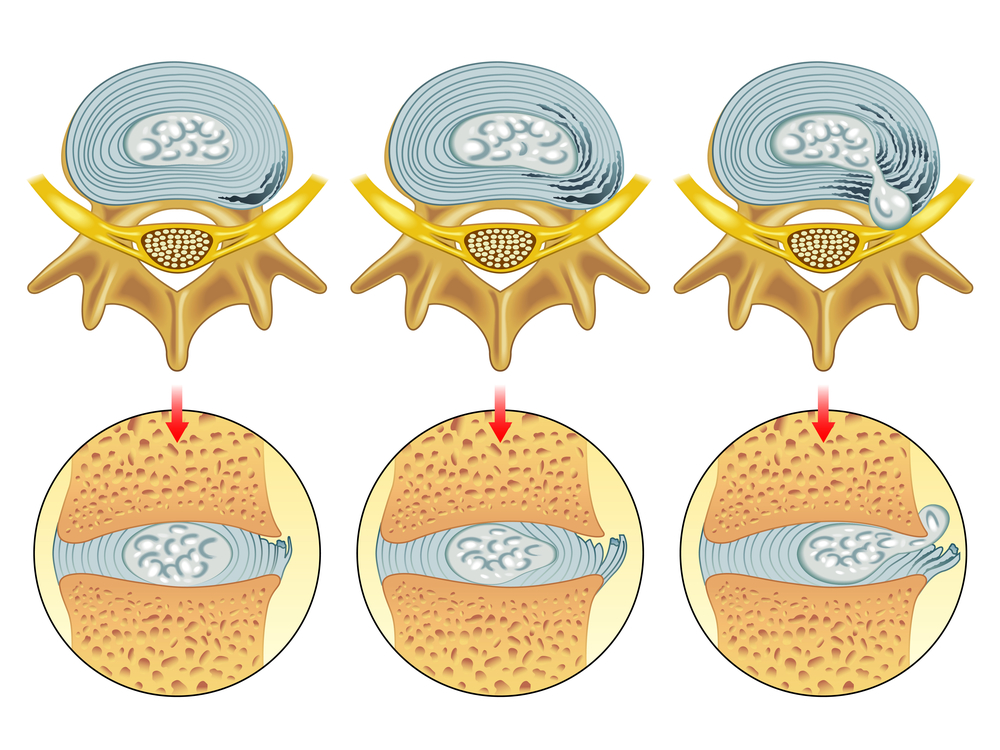
A bulging disc is when the back of the disc bulges out towards a nerve. A herniated disc is when the inner material from the disc has pushed out of the centre of the disc.
So, a bulging disc is a less severe version of a herniated disc, but they are both a similar problem with similar causes.
You would be forgiven for thinking that a herniated disc is always worse than a bulging disc – but this isn’t actually always the case. The severity of the injury seen on MRI does not always match up with the severity of the symptoms reported by the patient.
Both a bulging disc and a herniated disc can cause pain in the back and leg (called sciatica). Because of how close the discs are to the nerves that we talked about earlier, some of the inner material of the herniated disc, or the disc bulge itself, can trap a nerve. Let’s now talk about why that causes such a big problem for someone.
The Nerves
Inside the bones in the spine, there is a long hollow passageway. Through this passageway runs the spinal cord – the origin of all the nerves in our body.
From each level in the spine, a tiny portion of the spinal cord splits off and becomes a nerve. This nerve then leaves the spine and runs to a limb or other part of the body. The nerves are vital to human life – they allow us to move, feel, talk and digest food.
The longest nerve in the human body is the sciatic nerve. It leaves the spine near the bottom of the back and runs all the way down the back of the leg into the toes. It is around an inch in diameter and allows the legs to work normally.
Pinched Nerve from a Bulging or Herniated Disc
A pinched nerve occurs when something within the body touches a nerve and affected the way it functions. This usually happens in one of the tight spaces that the nerves run through within the body.
Because these spaces are so tight, the nerves are more vulnerable to being caught in these zones. One of the tightest areas that the nerves have to run through is the gap where they exit the spine.
The “walls” of these gaps are made up of bones (vertebrae), discs and ligaments. Normally, these gaps are absolutely fine – they provide enough space for the nerve to glide and slide within them.
However, if for some reason these gaps become further narrowed, this can cause a pinched nerve.
One of the common reasons for one of the gaps to become narrowed is a bulging disc or herniated disc.
Are You Looking for RAPID Relief from a Bulging or Herniated Disc?
My good friend, colleague and fellow international sciatica expert, Dean Volk, has a brand new sciatica relief video course available – and I’m delighted to be an official sponsor!
Check out Dean Volk’s “Kicking Sciatica OUT of the Butt!” Online Pain Relief Course Here!
I can proudly recommend Dean and his course for sciatica sufferers – because I’ve seen his incredible results first-hand. You can check out his course (and get lifetime access to the videos and bonus content) by clicking HERE.
Before we go any further, check out this video here where I explain how a disc bulge or disc herniation can cause such extreme pain:
What are the Symptoms of a Bulging Disc or Herniated Disc?
The symptoms of a bulging disc or herniated disc in the lower back include the following:
- Back Pain: Perhaps the most common symptom of a pinched nerve is back pain. Now, although this may surprise you, not everyone experiences back pain with a pinched nerve, but most people do.
- Sciatica: A pinched nerve from a herniated disc is the most common cause of sciatica. Sciatica is the word we use to describe the sensation of pain the runs down the back of the leg. It is usually shooting and can be severe – sometimes described by my clients as feeling like “being stabbed by a hot poker”.
- Pins and Needles/Numbness: A pinched nerve can cause sensory changes in the leg and foot. Usually, the funny sensations will be present in the foot and toes and for some people this symptom can be worse than the pain. This symptom happens because the pinched nerve is prevented from doing its job correctly. This means that some signals don’t get through properly and sensation isn’t felt normally.
- Weakness in the Legs: Now, this symptom can be alarming and you should definitely head to your doctor if you feel weakness in one or both legs along with any of the other symptoms on this list. Weakness in the legs (particularly calf weakness with a herniated disc L5/S1) indicates a severely pinched nerve from the herniated disc. If this sounds like you, it needs addressing as soon as possible.
Home Treatment for a Bulging Disc or a Herniated Disc
The most important thing to understand when it comes to a bulging or herniated disc and exercise is that everyone is different; a suitable exercise regime for one person with a herniated disc will be different for another with the same problem.
However, there are some exercises that are commonly useful for many people with a pinched nerve from a herniated disc.
Always get personalised medical advice before starting any new exercise programme to treat a bulging or herniated disc.
#1 – Cobra Pose
Instructions:
- Begin laying face-down on a firm surface like a mat on the floor or a hard mattress
- Place your hands in line with your shoulders and gently push up, raising your torso off the floor
- Keep your hips down on the floor
- Only go as far as is comfortable – no need to get to full extension for a benefit!
- Gently lower yourself to the starting position and repeat up to a maximum of 10 times.
- Do a set of these 3-4 times per day
Who this is for:
Usually, people suffering with a herniated disc causing a pinched nerve find this exercise one of the most useful for improving their symptoms. However, regardless of what is causing a pinched nerve, one should only persist with this exercise if it is comfortable to perform this movement. This exercise is often a good place to start for those who have trouble bending forward.
Why this exercise works:
This exercise works because it involves movement of the lower back which encourages blood to flow to the injured area so healing can occur. Some researchers also believe this exercise causes a disc herniation to “centralise” into the disc where it can’t pinch on a nerve root.
#2 – Knee Rolls
Instructions:
- Lie on your back on a mat or a firm mattress
- Bend your knees up halfway
- Slowly and gently, allow both knees to roll over to one side only as far as is comfortable
- Bring your knees back to the start position, then allow them to roll over to the opposite direction
- Repeat for 30-seconds total, don’t rush the repetitions and try to find a rhythm
- Try to find time to do this exercise every 2-3 hours if you can
Who this is for:
This pinched nerve exercise is great for relieving any tension in tight muscles in the lower back, which are a common symptom of a pinched nerve. It is also a great way to begin to regain any lost rotation in the lower back following a herniated disc.
Why this sciatica exercise works:
By gently encouraging a slow, controlled rotation of the lower back, the muscles in the lower back will realise that it is OK to relax a little. This will bring about herniated disc or bulging disc pain relief.
#3 – McKenzie Side Bends
Instructions:
- Start standing next to a wall. Most people prefer to do this exercise with their painful leg being the one FURTHEST AWAY from the wall. However, try both sides and see which one is most comfortable for you – stick with that one.
- Use your elbow and forearm to support yourself so you are leaning on the wall (1st picture)
- Slowly and gently, let your hips “glide” towards the wall while keeping your feet in the same position.
- Only go as far as is comfortable, then return to the start position.
- Repeat this 10 times, have a break, and do 3 sets total.
- If this exercise has worked for you, you may feel rapid relief in the painful leg and possibly slightly worsening back pain – rest assured this is a normal phenomenon.
Who this is for:
This exercise works really well for disc problems and is a mainstay for a treatment approach called “McKenzie”. If someone has pain in one leg from a disc bulge or herniation, I often get them to try this exercise. It brings significant sciatica pain relief to many and can work rapidly.
Why this sciatica exercise works:
The McKenzie approach claims to work by encouraging the disc material called the “nucleus” to re-centralise into its inner middle section. Whether or not this actually occurs hasn’t been proven in scientific literature but I have seen this exercise provide relief for many. Be sure to choose the direction that is least painful when performing this exercise.
#4 – Standing Extension
Instructions:
- Start standing normally.
- Gently try to lean back. Only go as far as is comfortable.
- If you feel able to, use your hands to provide support in the lower back allowing you to extend further (3rd picture)
- Slowly return to the start position
- Perform up to 10 repetitions, every few hours or so. Cut your set short as soon as you reach the first signs of pain.
Who this is for:
This is a great exercise for a herniated disc or a bulging disc. It works especially well for people who have trouble leaning forward and is a more user-friendly/convenient version of #1 on this list. However, I find it to be slightly less effective compared to the Cobra pose as I find people tend to rely more on pelvic rather than spinal movement with this one. You should AVOID this exercise if you suffer from arthritis of the lower back or spinal stenosis.
Why this herniated disc exercise works:
This exercise works in a similar way to #1 – it involves movement of the lower back, encouraging blood to flow to the injured area so disc healing can occur. This exercise may help a herniated disc to “centralise” into the inner disc where it can’t pinch on a nerve root.
Other Treatment Options for a Herniated Disc or Bulging Disc
Very rarely, surgery is required for a herniated disc or bulging disc to release the pinched nerve. This intervention is reserved for those who have tried everything else and are still suffering.
It’s important to exhaust all non-surgical methods first, as you can’t reverse a surgery and the results from surgery are often underwhelming. Occasionally, surgery can make someone worse which is obviously devastating to hear about.
Another option includes injections, which can give pain relief down the course of the sciatic nerve. From my experience, these have very underwhelming results for most people. However, they can occasionally be effective.
In the following video, I’ll share 8 effective strategies to SPEED UP the recovery of a bulging disc or herniated disc naturally:
My Final Recommendations for a Herniated Disc or Bulging Disc
Are You Looking for RAPID Relief from Sciatica?
My good friend, colleague and fellow international sciatica expert, Dean Volk, has a brand new sciatica relief video course available – and I’m delighted to be an official sponsor!
Check out Dean Volk’s “Kicking Sciatica OUT of the Butt!” Online Pain Relief Course Here!
I can proudly recommend Dean and his course for sciatica sufferers – because I’ve seen his incredible results first-hand. You can check out his course (and get lifetime access to the videos and bonus content) by clicking HERE.
Conclusion
So, we can see from this article that a herniated disc and a bulging disc are similar problems on the same continuum, with one being a more severe version of the other. Disc problems are the most common cause of a pinched nerve in the lower back, but there are other problems that can cause sciatica it’s best to get checked out by a doctor or healthcare professional if you’re not sure. There are often ways that you can treat and bulging or herniated disc without needing to go through traumatic surgery.
So, what’s your experience with a bulging or herniated disc been? Have you found anything that helps? Leave a comment below.
The information on Overcome Sciatica should never be used as a substitute for medical advice from a doctor. Never put into action any tips or techniques from Overcome Sciatica without checking with your doctor first. Please see full terms of use here.

